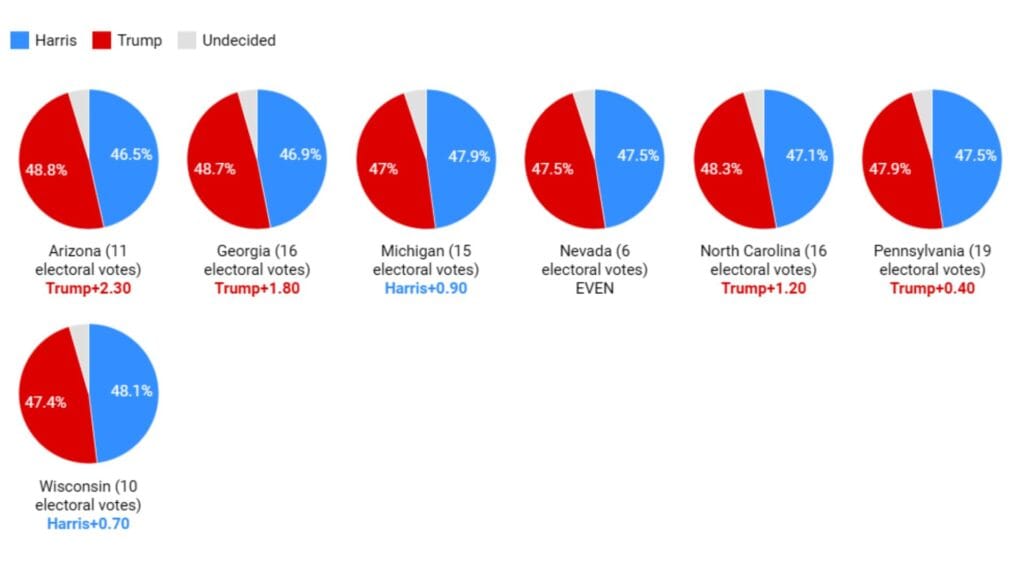Both Vice President Kamala Harris and former President Donald Trump are now pulling out all the stops with only a few days remaining until the U.S. election, but both will do it in ways that differ from each other, where Trump heads to Michigan and Harris to Wisconsin, showing that both candidates have emphasized on different key issues to energize their respective bases of support. Harris rallied much of Thursday on the possibility that the right to an abortion would be at stake, an issue that burns strongly with her base. Trump, meanwhile, campaigned heavily on immigration and border security issues he believed most undecided voters and all of his base cared most deeply about areas concerned by the thought of losing border control.
What the Polls Show
According to the latest reports, there is a very tight race. The election may go either way. AtlasIntel reports that Trump is leading Harris by a slim margin of one to two points. However, TIPP Insights reported that the two candidates have tied up. The result shows a neck-and-neck competition, and FiveThirtyEight’s national polls tracker reports that Harris has only a 1.2-point advantage nationally. Based on this margin of error, it’s fair to say the election could go either way. The proximity of the races creates an anxious atmosphere: every campaign is aware that there’s room for no mistakes, in the scramble for each vote.
Additionally, a survey by the Associated Press-NORC Center indicated that 70 percent of Americans felt anxious or frustrated about the elections. What’s interesting, however, is that this anxiety cuts across the ideological boundary between Democrats and Republicans with the slight edge held by Democrats being more nervous about this result. Widespread anxiety can work for very large turnouts on election day or send people scurrying in the opposite direction altogether. I’d suppose that this apprehension could get more people out voting and voicing themselves in such a polarized setting, to be heard in a frenetic effort to create change.
Swing State Showdown
The focus of both campaigns remains squarely on swing states that could decide the election. Among those swing states are Pennsylvania, North Carolina, Georgia, Michigan, Arizona, Wisconsin, and Nevada. According to FiveThirtyEight, Harris has a slight edge in Michigan and Wisconsin, while Trump is gaining ground in Nevada and Arizona. The polls in these states are razor-thin, meaning even the smallest shifts in public opinion could have a big impact on the final results.
For example, Trump now leads by 2.4 points in Arizona and 1.8 in Georgia, while Harris still holds a small edge in Wisconsin and Michigan. This could very well be a country severely split in which regional and local issues carry more weight than at any other time in history. I believe that if either candidate can win most of the swing states, that’s how it’s going to tip. But with such a hair’s breadth, it’s hard to say how the states will fall.

Kamala Harris’s Final Push
Harris’s campaign pounced on those comments Thursday, denouncing Trump as “offensive” for saying women would be protected “whether they like it or not.” That seems to dismiss women’s control over their lives and bodies, Harris said. She seized once more on her stance defending abortion rights issues she believes might rally female and younger voters on issues of personal freedom.
While speaking to supporters in Phoenix, Harris’s rally featured Mexican American band Los Tigres del Norte to perform a song that symbolized unity across the U.S.-Mexico border. Harris acknowledged protesters advocating for Palestinian causes during her speech and promised to focus on peace efforts and the Gaza crisis if elected. Interestingly, Harris balances her platform. She seems to be trying to appeal to a broad spectrum, from issues of social justice to important economic and foreign policy issues. That inclusive approach may prove to be in her favor, especially with voters concerned about human rights and international diplomacy.
Trump’s Rally Strategy
Trump has anchored his campaign on immigration and economic issues. At a rally in New Mexico, he promised to fix the border problems and control inflation. Trump attacked Harris’s border policies, saying they are weak and threatening a mass deportation program if elected. He has framed the election as a choice between safety and chaos, portraying himself as the only candidate who could bring stability. He speaks a lot about these issues and is trying to gain more states like Nevada that are badly hit by the pandemic. Nevada has one of the highest unemployment rates in the U.S. So, Trump has made several statements regarding inflation and the high gas prices-a straight issue for the people to vote for.
Speaking along economic lines even vowing to eliminate federal taxes on tips, for example, on an entirely separate event in Arizona with Tucker Carlson, the president emphasized his ability to focus on the economy, which resonates with so many Nevadans: He would have an edge in the critical state. I do believe that Trump’s attempt to hone in on the economy will resonate with many who feel the government has not done enough for their financial struggles. Maybe his rhetoric on immigration issues will repel more moderate voters who are voting for economic policies and who disagree with his harsh stands on immigration.
What’s Next?
Then, in the final hours before the polls close in Wisconsin, Harris and Trump are rushing across that state to cement every last possible vote. Harris remains there Wednesday, emphasizing reproductive rights and economic equality. The hip-hop icons Cardi B and The Isley Brothers performed for Harris at a Milwaukee rally, a key part of her campaign’s emphasis on younger voters.
In other words, Trump will come to Michigan. He hopes in this state primarily because there is a gigantic Arab American population. One should remember that his plans include a visit to Dearborn, an Arab-majority populated city. Frequently, this segment of citizens turns out to be an electorate swing factor in this state. And it’s a serious trump card.
Both of the candidates are pulling out all the stops with literally not much to lose at this point. If I had to summarize it all then, for sure, this is an election that is as much about policy as it is about personality and public mood. When both sides are this close in the polls anything can happen. It will be a close race and, while both candidates have strong supporters, it most likely comes down to swing states and undecided voters. The next few days will be intense as each candidate fights for every last vote.
Analysis by Atul Raj






